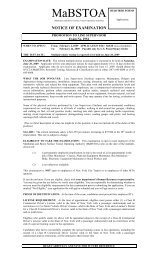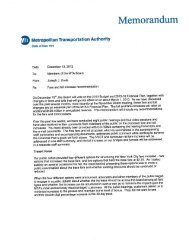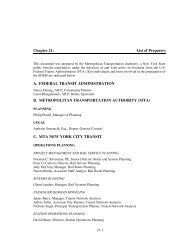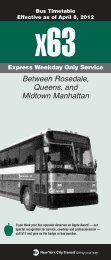Greening Mass Transit & Metro Regions: The Final Report - MTA
Greening Mass Transit & Metro Regions: The Final Report - MTA
Greening Mass Transit & Metro Regions: The Final Report - MTA
Create successful ePaper yourself
Turn your PDF publications into a flip-book with our unique Google optimized e-Paper software.
TRANSFORMATIONAL RECOMMENDATIONS<br />
Recommendation 1. Develop and Implement a Climate-Adaptation Decision-Making Matrix<br />
Over the next three to five years, the <strong>MTA</strong> should apply a climate-adaptation decision-making matrix/process to identify<br />
options for protecting vulnerable rapid transit infrastructure from storm surge, extreme heat, and other manifestations of<br />
climate change that have already occurred and cannot be mitigated by other strategies. In light of the scale of the climateadaptation<br />
risks and vulnerabilities for subway lines at or below sea level, commuter rail lines, and bridges and tunnels, the<br />
<strong>MTA</strong>, like other rapid transit agencies around the nation, must look to the states and federal government for financing to<br />
make long-term climate adaptation investments, many of which should ideally begin now, with significant adaptations<br />
completed or underway no later than 2030.<br />
Climate-Adaptation Decision-Making Matrix<br />
↑<br />
Value<br />
Risk →<br />
Low<br />
Medium<br />
Facilities that have a great impact on the system are deemed high-value and those that are low-lying or otherwise vulnerable<br />
are considered high-risk. For instance, an elevated station could be considered low-risk and, in the absence of a systemwide<br />
impact, considered low-value and may be placed in the bottom left-hand cell, whereas a trainyard on the water’s<br />
edge, with system-wide impact and vulnerability may be put into the top right-hand cell.<br />
NEAR-TERM RECOMMENDATIONS<br />
Recommendation 1: Adopt <strong>MTA</strong> Climate-Adaptation Policy Position<br />
By mid-2009, the <strong>MTA</strong> should have a basic adaptation policy in place. In effect, the policy should state the following.<br />
(1) <strong>The</strong> <strong>MTA</strong> is aware that adaptation to climate change is a necessity without which a stable, prosperous, and sustainable<br />
economy of the region and a reliable functioning of its transportation infrastructure cannot be achieved. (2) <strong>The</strong> <strong>MTA</strong> is<br />
committed to developing a strategic adaptation master plan with basic performance standards and milestones to achieve<br />
them. (3) <strong>The</strong> <strong>MTA</strong> will coordinate its adaptation efforts with those of other infrastructure operators, utilities, and local and<br />
regional planning efforts to foster a coherent action plan for the region, in which the transportation sector cannot proceed<br />
in isolation. (4) <strong>The</strong> <strong>MTA</strong> is committed to taking a leading role and setting a national example for making the largest mass<br />
transit system in the nation resilient to the challenges of climate change. (5) <strong>The</strong> <strong>MTA</strong> recognizes that both mitigation and<br />
adaptation strategies need to be balanced and pursued to achieve a sustainable future.<br />
Recommendation 2: Implement Operational Climate Change Database<br />
By the end of 2010, the <strong>MTA</strong> should have established a climate change database (or secured access to such a database).<br />
It should contain information on future trends of climate parameters, including but not limited to temperature, precipitation,<br />
floods, storms, and coastal storm surge patterns, as well as sea-level-rise (SLR) forecasts, for which it needs to undertake<br />
meaningful adaptation measures. <strong>The</strong> information should be in a form that provides a sound scientific-technical foundation<br />
for making the best strategic, operational, engineering, and management decisions for adaptation policies. Both mean<br />
trends and parameter variability (quantifying the magnitude and frequency of extreme weather and climate events) should<br />
be included. This compilation of climate forecasts should be updated on a regular basis at least every five years, or earlier<br />
when important new scientific data or forecasts become available. It should have enough spatial resolution, must serve the<br />
entire <strong>MTA</strong> service area, and should include forecasts out to at least 100 years and in some cases longer, to the extent that<br />
this is scientifically feasible. An essential part of the effort is to quantify the uncertainties by providing a measure of confidence<br />
for the provided forecasts and for different time horizons. <strong>The</strong> climate forecast data should be readily accessible to<br />
<strong>MTA</strong> staff, preferably online and in standard formats (where applicable for use in GIS or CAD applications) to allow ready<br />
use for day-to-day decisions. <strong>The</strong> <strong>MTA</strong> should partner with other infrastructure operators in the region to coordinate<br />
regional databases and may want to do this in cooperation with the NYC Climate Change Adaptation Task Force and its<br />
New York Panel on Climate Change (NPCC), or equivalent state-based efforts.<br />
High<br />
59
















